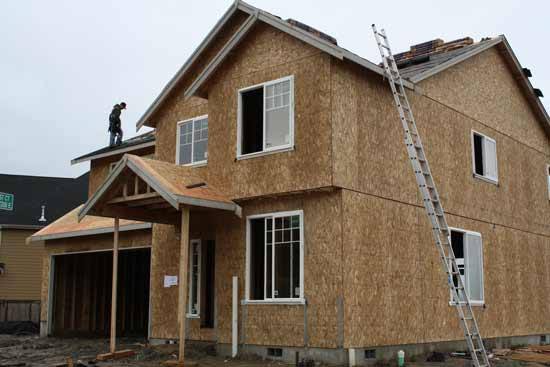The sounds of nails being blasted into lumber and shingles being laid on rooftops ring out across the Panorama Heights neighborhood of Bonney Lake, but according to a report at this week’s city council meeting, to a city, home construction makes a different sound: Cha-ching.
According to economist Elliot Eisenberg, whose hour-long presentation titled “The Metro Area Impact of Home Building in Bonney Lake, Wash.: Income, Jobs and Taxes Generated” opened the Feb. 14 council meeting, the economic impact of a new home can be up to approximately $1.3 million in the first year with a continuing contribution of nearly $86,000 per year once people move into the home.
“Houses being built here in the city are bringing a tremendous amount of gross revenue to the community and a tremendous amount of net income … to the overall community,” Eisenberg said.
According to Eisenberg, there are three phases of economic impact that revolve around house construction. First comes the “construction phase” and the “ripple phase” which lasts about every eight months and generates revenue to the city through permit costs as well as providing an influx of cash into the retail economy through the supplies needed and the wages paid to – and presumably spent by – employees.
“This generates a lot of economic steam,” Eisenberg said. “As this money gets spent it courses through the economy.”
Eisenberg said for every 35 homes built, approximately $4.8 million in income and $1.3 million in taxes are generated in the construction phase, including about 71 local jobs. The ripple phase brings in about $2.8 million in income and $335,000 in taxes, as well as 46 jobs for every 35 homes built.
The final phase is known as the “occupancy phase” and occurs after a family moves in to the home and begins spending money in the community. Though it generates less money each year, the occupancy phase is ongoing for the life of the house, generating approximately $680,000 a year in income, $233,000 in taxes and 12 local jobs per 35 homes.
However, for a city, the occupancy phase in the one in which the most costs are incurred as services are provided to those residents.
Eisenberg estimated that it costs a city about $4,200 per house to provide services, but they generate an estimated $6,880 in revenue, making each new home generally profitable to the city.
Home construction in Bonney Lake continues to progress, but the 74 permits issued in 2011 fall well short of a high of 329 in 2002 and a pre-recession number of 233 in 2007.
Deputy Mayor Dan Swatman organized the presentation and said he did so because he wanted to make sure the entire council had all of the facts on homebuilding and the money it can generate.
Swatman said there are about 700 lots ready for construction in Bonney Lake ready and waiting for homes to be built.
“I don’t want to be mowing down forests to build new homes, but there are lots sitting empty,” he said, adding that there are already service costs associated with the lots. “We’re paying to plow that whole street.”
Swatman also said he hoped to spur a discussion about the city’s impact and permit fees as a way to spur building. Swatman said the development community has made it clear that Bonney Lake’s fees are quite high compared to PIerce County’s, something Eisenberg confirmed.
“Too high is a relative question,” he said, responding to a question from the council. Eisenberg said Bonney lake’s are about three times higher than the county’s.
“It’s unusual to see that profound a difference,” he said. “It does have impact. It has to have impact.”
But Eisenberg said some localities can have high fees because people want to be there, something with which councilmember Jim Rackley agreed.
Swatman said he was interested in revisiting the city’s impact fees this year, but only to find a different way to pay for services, which he said should pay for themselves.
“Our fees are what they are because they cost us that much (to provide services),” he said.
Swatman said the presentation cost the city about $2,000, but said the information provided was well worth the cost.
“I haven’t heard a lot of that anywhere else,” he said.



